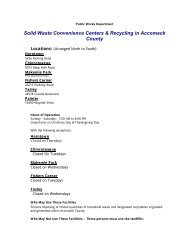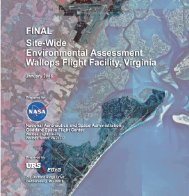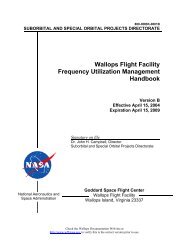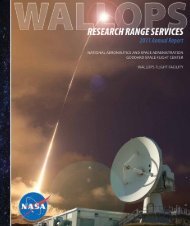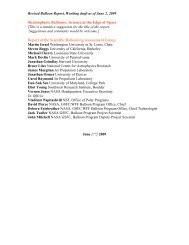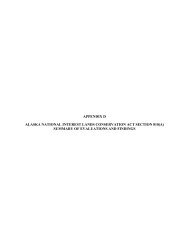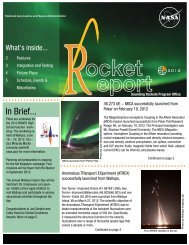Alternative Energy Draft EA - NASA Visitor Center at Wallops Flight ...
Alternative Energy Draft EA - NASA Visitor Center at Wallops Flight ...
Alternative Energy Draft EA - NASA Visitor Center at Wallops Flight ...
You also want an ePaper? Increase the reach of your titles
YUMPU automatically turns print PDFs into web optimized ePapers that Google loves.
Affected Environment<br />
On the southern part of <strong>Wallops</strong> Island, the dune and swale zone extends to the tidal marsh on<br />
the western side of <strong>Wallops</strong> Island with no maritime forest present. In the central and northern<br />
areas, the dune and swale zone extends to the maritime zone th<strong>at</strong> starts where the secondary dune<br />
line once existed. The central portion of <strong>Wallops</strong> Island is domin<strong>at</strong>ed by common reed, an<br />
invasive undesirable species, and maintained lawn areas. Due to its successful competition with<br />
many other plant species, the common reed has virtually taken over much of the area in the<br />
center of <strong>Wallops</strong> Island. A small area of maritime forest domin<strong>at</strong>ed by loblolly pine (Pinus<br />
taeda) and cherry trees (Prunus spp.), with an understory of northern bayberry, wax myrtle, and<br />
groundsel-tree, exists on the central portion of the island. The northern part of <strong>Wallops</strong> Island<br />
within the dune and swale zone is in an almost n<strong>at</strong>ural st<strong>at</strong>e, and is domin<strong>at</strong>ed by northern<br />
bayberry (Morella pensylvanica), wax myrtle (Morella cerifera), groundsel-tree (Baccharis<br />
halimifolia), and American beachgrass.<br />
An area of tidal marsh encompasses 1,130 hectares (2,800 acres) between <strong>Wallops</strong> Island and<br />
<strong>Wallops</strong> Mainland. As the marshes provide suitable habit<strong>at</strong> for both foraging and reproduction,<br />
these areas are of tremendous importance to marine life and many terrestrial and avian species.<br />
<strong>Wallops</strong> Main Base<br />
The veget<strong>at</strong>ive zones from east to west on <strong>Wallops</strong> Main Base are marsh, thicket, and upland<br />
forest. Inland communities such as fresh and brackish marsh, xeric and mesic shrub, p<strong>at</strong>ches of<br />
open ground, areas completely covered by pine, and pine-deciduous mixed woodlands are often<br />
separ<strong>at</strong>ed from one another by a sharp topographic change. Small rich remnants of upland<br />
forests and swamps occur on the Main Base. Dominant species in the upland forest include<br />
loblolly pine, various oaks (Quercus sp.), hickory (Carya sp.), tulip-poplar (Liriodendron<br />
tulipifera), dogwood (Cornus florida), sweetgum (Liquidambar styraciflua), red maple (Acer<br />
rubrum), and sassafras (Sassafras albidum). Black willow (Salix nigra) and red maple are<br />
dominant species in the swamps. The tidal marsh found on <strong>Wallops</strong> Main Base is similar to the<br />
tidal marsh on <strong>Wallops</strong> Island. Fields, pine forests, lawns, buildings, and pavement are present<br />
throughout the Main Base.<br />
3.2.2 Terrestrial Wildlife<br />
<strong>Wallops</strong> Island and <strong>Wallops</strong> Main Base host both terrestrial and aqu<strong>at</strong>ic forms of fauna th<strong>at</strong><br />
comprise their biotic communities. Terrestrial and aqu<strong>at</strong>ic species are particularly concentr<strong>at</strong>ed<br />
in the tidal marsh areas, which provide abundant habit<strong>at</strong>.<br />
3.2.2.1 Invertebr<strong>at</strong>es<br />
<strong>Wallops</strong> Island, particularly the tidal marsh area, has an extensive variety of invertebr<strong>at</strong>es.<br />
Saltmarsh cordgrass marshes have herbivorous (plant-e<strong>at</strong>ing) insects such as the saltmarsh<br />
grasshopper (Orchelium fidicinium) and the tiny plant hopper (Megamelus spp.). Plant hopper<br />
eggs are in turn preyed upon by a variety of arthropods, the group of animals th<strong>at</strong> includes<br />
insects, spiders, and crustaceans. The tidal marshes are inhabited by a number of parasitic flies,<br />
wasps, spiders, and mites. The spiders prey mostly on herbivorous insects, and mites prey<br />
primarily on microarthropods (small invertebr<strong>at</strong>es) found in dead smooth cordgrass. Saltmarsh<br />
mosquitoes (Ochlerot<strong>at</strong>us sollicitans) and greenhead flies (Tabanus nigrovitt<strong>at</strong>us) are prevalent<br />
insects on <strong>Wallops</strong> Island. Periwinkle snails (Littorina irror<strong>at</strong>a) and mud snails (Ilyanassa<br />
obsoleta) are found on the marsh surface.<br />
50




